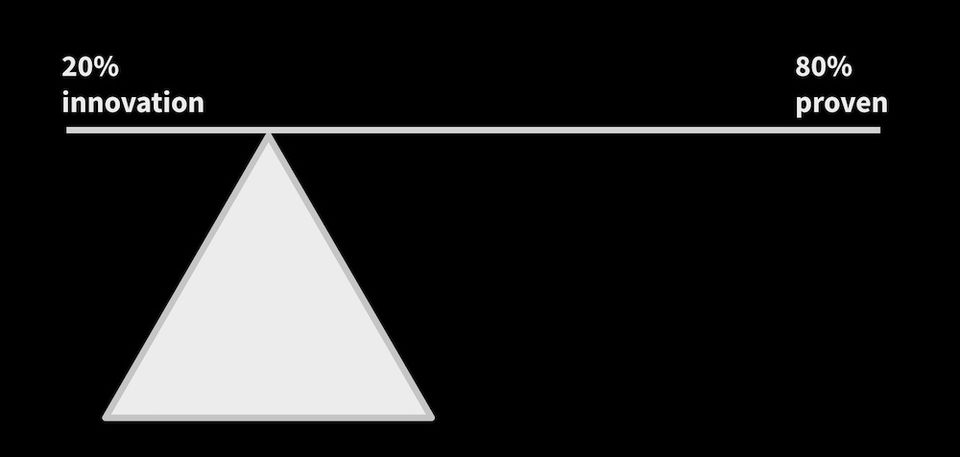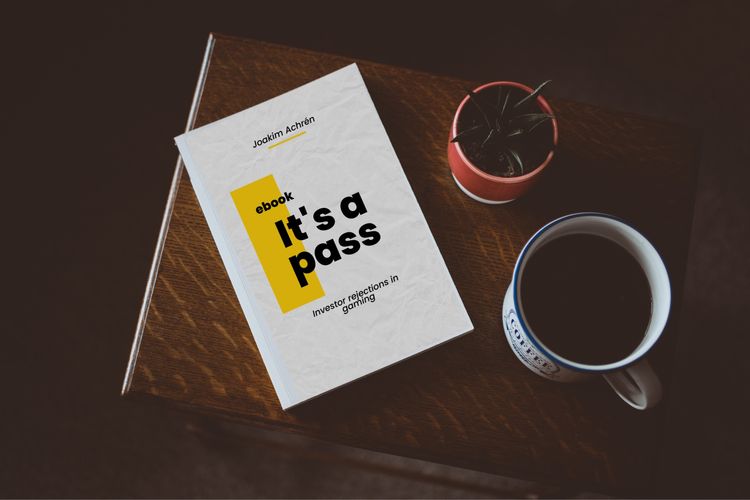EGD News #122 — 80% proven, 20% innovation

Sent on February 18th, 2022.
If you aren’t a subscriber to EGD News, you can subscribe here.
🎯 80% proven, 20% innovation
There’s only stuff worth stealing, and stuff that’s not worth stealing.
— Austin Kleon in Steal Like an Artist
I want to talk about not reinventing the wheel. In the games companies I’ve previously worked at, we’ve always strived to build games by the rule of 80% proven 20% innovation.
The one thing I love about hyper-casual mobile game development is the breakneck pace at which they develop games. On a recent podcast, Voodoo’s Corentin Selz told me that they are testing thousands of games yearly on the App Store to see which have good enough KPIs. Despite their fast pace, they keep lots of what worked in previous games and build on top of their learnings.
Why should you pick things that have been proven? Why not go full-on with innovation?
There are two reasons:
- The first is that something has worked for an audience. Existing, working things are the definition of what is liked. Our job as game developers is to improve on what has worked, to deliver even more incredible experiences for the audience.
- The second is that it increases the likelihood of getting something out that works. We are building businesses that last, and often, this means that we want to deliver something that people feel is worth spending money on.
Working with 80/20 in mind
We have always been shameless about stealing good ideas.
— Steve Jobs
The problem I’ve seen come up over and over when talking to developers: How to define if your game design is 80% proven, 20% innovation and how do you know if it’s not?
Adding a twist to the familiar is the simplification of the 80/20, but it misses essential details.
I’ve seen game designers who are like walking game design encyclopedias. They have millions of things in their head from the games they’ve played over the decades. They have Dropbox folders full of screenshots from games. They’ve drafted countless game concepts in Google Docs.
But I’ve noticed that the real artists are the ones who distinctively know which ideas are worth returning to.
In How to Take Smart Notes, author Sönke Ahrens argues:“Even if you don’t aim to develop a grand theory and just want to keep track of what you read, organize your notes and develop your thoughts, you will have to deal with an increasingly complex body of content, especially because it is not just about collecting thoughts, but about making connections and sparking new ideas.”
You got to experiment to develop better connections with your hypothesis on what is proven and the innovations you are planning.
Experimenting to find the connection
Immature poets imitate; mature poets steal; bad poets deface what they take, and good poets make it into something better, or at least something different. The good poet welds his theft into a whole of feeling which is unique, utterly different than that from which it is torn.
— TS Elliot
Here are things I’ve seen that were grand attempts on 80/20 but still failed. I’ll attempt to decipher why they failed.
First, a few words on the generalization of mixing the proven with innovation.
A usual attempt is to plug in a proven metagame and unproven core gameplay. If it doesn’t work, you flip it and then try it the other way. There is a problem: you’re unsure which part of the existing hit game was the proven part for that game. You think you know, but you always don’t.
When making games with 80/20 in mind, it’s critical to know when you’re innovating on 20 and not on the 80. Imagine a balanced board with equal weight on the left and right sides. But the center of gravity is not centered; it’s located on the 20% from the left.
You don’t want to tip your game off balance. Otherwise, you will push it too much towards the unproven innovative end.
Examples where the balance wasn’t right
Hoarders collect indiscriminately, and the artists collect selectively
— Austin Kleon in Steal Like an Artist
Niantic launched Pokemon Go in 2016, which was a huge success. Three years later, they brought out a location-based Harry Potter game to the market. To everyone’s amazement, that game didn’t do well. The lesson: Pokemon Go is a proven Pokemon game with a twist. That twist being the location-based gameplay element.
Here’s another one. Clash of Clans came out in 2012, and it stormed the top-grossing charts and never went away.
Several developers (including yours truly) rushed to build more games into that same genre in the following years. It’s was a gold rush, nothing dissimilar to what the race to NFTs and play-and-earn are causing now in 2022.
There was a Samurai-themed one, a Wild West one, a Pirates one, a Star Wars IP-based one, a Transformers IP based one. Some developers even launched three build-battlers.
These fast-followers kept the gameplay very similar and built up all the needed bells and whistles. To compete in the genre, developers placed most of their 20% on the thematics and the art style, to distinguish themselves from Clash of Clash. But at the same time, unit readability suffered, and the appeal of high-fantasy barbarians, giants, and sorcerers wasn’t there.
But one developer did succeed. Chinese developer IGG launched Castle Clash in 2013, and it became the only game that worked, reaching the top 25 grossing and sustaining its position on the charts for years. The lesson: IGG kept lots from Clash of Clans by keeping the build and battle with the proven fantasy theme.
What was IGG’s innovation and 20%? They doubled down on the hardcore RPG segment that loved Clash of Clans but would like to collect and upgrade a vast roster of heroes. This allowed the game to have high long-term player engagement and monetization, a requirement for mobile success.
On top of the depth, Castle Clash had an equally accessible style as Clash of Clans, but the key was that it looked and felt different enough from Clash of Clans.
Merge Dragons introduced a new kind of gameplay to the masses called Merge. In 2020, Metacore soft-launched a game called Merge Mansion, where they took the tried and true merging mechanics as proven.
As 20%, Metacore added readability: With the 2D merge board, players are more focused on the tasks at hand and not scrolling and moving things around all the time as in the isometric board. This increases player flow and satisfaction for the audience.
On the visual side, the items you’d be merging became more relatable, which is a big plus for the casual audience. The result was much higher retention across the early and late game.
To summarize
If successful innovation is defined by creating games that can generate $100m, what was the right formula for the 80/20?
- UX differentiation, superior readability (all games)
- Relying on familiar concepts (Pokemon game, Merge Mansion)
- Doubling down on needs to adjacent audience segments (Castle Clash)
There are countless other examples of adding the correct 80% proven and 20% innovation. I’d be happy to hear your thoughts on great examples, so don’t hesitate to contact me on LinkedIn with your ideas.





